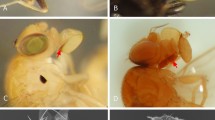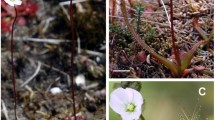Abstract
Flowers of most species in the genus Ceropegia have elaborate adaptations to trap pollinating flies. Flies are trapped within a bulbous base of the flower after moving through an elongated corolla tube that is frequently lined with stiff hairs. When these hairs wilt after several days, insects held in the bulbous chamber at the base of the corolla tube are released. Despite such complex adaptations for trapping pollinators, key aspects of the pollination ecology including the identity of pollinators, presence or absence of nectar rewards, duration of pollinator trapping, and pollination success remain undescribed for most Ceropegia species. Importantly, no studies have empirically tested the role that trapping hairs may have on pollen export and receipt. We documented the pollination biology of Ceropegia ampliata in two natural populations and found that C. ampliata can be regarded as a generalist, being pollinated by flies from at least four families (Tachinidae, Sarcophagidae, Muscidae, and Lauxaniidae). The duration of the trapping phase lasted 2–5 days and flowers produce small quantities of nectar. Pollination success was highly variable but generally low with occasional peaks suggesting that flies are likely to visit this species sporadically. Flowers that had already proceeded beyond the trapping phase generally had a significantly greater number of pollinaria removed than flowers that were still in the trapping phase, probably reflecting the longer exposure to pollinators. In contrast we found no differences in pollinarium removal between flowers with trapping hairs present and flowers with hairs experimentally disabled. The role of trapping hairs in the pollination success of C. ampliata therefore remains uncertain although we propose, on the basis of this experiment, that trapping may be an adaptation to enhance female success through pollen deposition rather than pollen export. Given the low rates of natural pollen deposition, an experiment with a large number of replicates is required to test this hypothesis in Ceropegia.



Similar content being viewed by others
References
Albre J, Quilichini A, Gibernau M (2003) Pollination ecology of Arum italicum (Araceae). Bot J Linn Soc 141:205–214
Anderson B, Johnson SD (2009) Geographical co-variation and local convergence of flower depth in a guild of fly-pollinated plants. New Phyt 182:533–540
Berjano R, de Vega C, Arista M, Ortiz PL, Talavera S (2006) A multi-year study of factors affecting fruit production in Aristolochia paucinervis (Aristolochiaceae). Am J Bot 93:599–606
Blanco MA, Barboza G (2005) Pseudocopulatory pollination in Lepanthes (Orchidaceae: Pleurothallidinae) by fungus gnats. Ann Bot 95:763–772
Bruyns PV (2005) Stapeliads of Southern Africa and Madagascar. Umdaus Press, South Africa
Burgess KS, Singfield J, Melendez V, Kevan PG (2004) Pollination biology of Aristolochia grandiflora (Aristolochiaceae) in Veracruz, Mexico. Ann Mo Bot Gard 91:346–356
Coombs G (2010) Ecology and degree of specialization of South African milkweeds with diverse pollination systems. PhD thesis, Rhodes University, South Africa
Coombs G, Peter CI, Johnson SD (2009) A test for Allee effects in the self-incompatible wasp-pollinated milkweed Gomphocarpus physocarpus (Asclepiadoideae). Austral Ecol 34:688–697
Coombs G, Peter CI (2010) The invasive ‘mothcatcher’ (Araujia sericifera Brot.; Asclepiadoideae) co-opts native honeybees as its primary pollinator in South Africa. AoB Plants 2010(plq021):1–14
Dafni A (1984) Mimicry and deception in pollination. Annu Rev Ecol Syst 15:259–278
Dold AP (2006) Ceropegia macmasteri (Apocynaceae–Asclepiadoideae–Ceropegieae), a new species from Eastern cape, South Africa. S Afr J Bot 72:144–146
Dyer RA (1983) Ceropegia, Brachystelma and Riocreuxia in Southern Africa. A.A. Balkema publishers, Rotterdam
Elberling H, Olesen JM (1999) The structure of a high latitude plant-flower visitor system: the dominance of flies. Ecography 22:314–323
Faegri K, van der Pijl L (1979) The principles of pollination ecology. Pergamon press, Oxford
Fenster CB, Armbruster WS, Wilson P, Dudash MR, Thompson JD (2004) Pollination syndromes and floral specialization. Annu Rev Ecol Evol Syst 35:375–403
Griffin AR, Hingston AB, Ohmart CP (2009) Pollinators of Eucalyptus regnans (Myrtaceae), the world’s tallest flowering plants species. Aust J Bot 57:18–25
Goldblatt P, Manning JC (2000) The long-proboscid fly-pollination system in Southern Africa. Ann Mo Bot Gard 87:146–170
Goldblatt P, Bernhardt P, Vogan P, Manning JC (2004) Pollination by fungus gnats (Diptera: Mycetophilidae) and self-recognition sites in Tolmeia menziesii (Saxifragaceae). Plant Syst Evol 244:55–67
Herrera I, Nassar JM (2009) Reproductive and recruitment traits as indicators of the invasive potential of Kalanchoe diagremontiana (Crassulaceae) and Stapelia gigantea (Apocynaceae) in a Neotropical Arid Zone. J Arid Environ 73:978–986
Heiduk A, Brake I, Tolasch T, Frank J, Jurgens A, Meve U, Dotterl S (2010) Scent chemistry and pollinator attraction in the deceptive trap flowers of Ceropegia dolichophylla. S Afr J Bot 76:762–769
Hoare DB, Mucina L, Rutherford MC, Vlok JHJ, Euston-Brown DIW, Palmer AR, Powrie LW, Lechmere-Oertel RG, Proches SM, Dold AP, Ward RA (2006) Albany Thicket Biome. In: Mucina L, Rutherford MC (eds) The vegetation of South Africa, Lesotho and Swaziland. Strelitzia 19. South African National Biodiversity Institute, Pretoria, pp 541–567
Jauker F, Wolters V (2008) Hoverflies are efficient pollinators of oilseed rape. Oecologia 156:819–823
Johnson SD, Neal PR, Harder LD (2005) Pollen fates and the limits on male reproductive success in an orchid population. Biol J Linn Soc 86:175–190
Johnson SD, Steiner KE (1994) Efficient pollination of the mass-flowering Cape orchid Disa obtusa Lindl. (Orchidaceae) by Bibio turneri Edwards (Diptera: Bibionidae). Afr Entomol 2:64–66
Karuppusamy S, Pullaiah T (2009) Pollination systems and ex-situ fruit set in Ceropegia juncea Wight (Apocynaceae)––an endemic species in India. Acad J Plant Sci 2:242–245
Kearns CA (1992) Anthophilous fly distribution across an elevation gradient. Am Mid Nat 127:172–182
Knuth P (1905) Handbook of flower pollination: based upon Herman Muller’s work. The fertilization of flowers by insects. Clarendon Press, Oxford
Larson BMH, Kevan PG, Inouye DW (2001) Flies and flowers: taxonomic diversity of anthophiles and pollinators. Can Entomol 133:439–468
Lehnebag CA, Robertson AW (2004) Pollination ecology of four epiphytic orchids of New Zealand. Ann Bot 93:773–781
Masinde PS (2004) Trap-flower pollination in East-African Ceropegia. Int J Trop Insect Sci 24:55–72
Mesler MR, Ackerman JD, Lu KL (1980) The effectiveness of fungus gnats as pollinators. Am J Bot 67:564–567
Meve U, Liede S (1994) Floral biology and pollination in stapeliads––new results and a literature review. Plant Syst Evol 192:99–116
Nepi M (2007) Nectary structure and ultrastructure. In: Nicolson SW, Nepi M, Pacini E (eds) Nectaries and Nectar. Springer, Netherlands
Okuyama Y, Kato M, Murakami N (2004) Pollination by fungus gnats in four species of the genus Mitella (Saxifragaceae). Bot J Linn Soc 144:449–460
Oelschlagel B, Gorb S, Wanke S, Neinhuis C (2009) Structure and biomechanics of trapping flower trichomes and their role in the pollination biology of Aristolochia plants (Aristolochiaceae). New Phytol 184:988–1002
Ollerton J, Diaz A (1999) Evidence for stabilizing selection acting on flowering time in Arum maculatum (Araceae): the influence of phylogeny on adaptation. Oecologia 119:340–348
Ollerton J, Masinde S, Meve U, Picker M, Whittington A (2009) Fly pollination in Ceropegia (Apocynacae: Asclepiadoideae): biogeographic and phylogenetic perspectives. Ann Bot 103:1501–1514
Pauw A, Stofberg J, Waterman RJ (2009) Flies and flowers in Darwin’s race. Evolution 63:268–279
Pansarin ER (2008) Reproductive biology and pollination of Govenia utriculata: a syrphid fly orchid pollinated through a pollen-deceptive mechanism. Plant Spec Biol 23:90–96
Pellmyr O (1989) The cost of mutualism: Interactions between Trollius europaeus and its pollinating parasites. Oecologia 78:53–59
Peter CI, Johnson SD (2006a) Anther cap retention prevents self-pollination by elaterid beetles in the South African orchid Eulophia foliosa. Ann Bot 97:345–355
Peter CI, Johnson SD (2006b) Doing the twist: a test of Darwin’s cross-pollination hypothesis for pollinarium reconfiguration. Biol Lett 2:65–68
Peter CI, Johnson SD (2008) Mimics and Magnets: The importance of color and ecological facilitation in floral deception. Ecology 89:1583–1595
Peter CI, Johnson SD (2009) Reproductive biology of Acrolophia cochlearis (Orchidaceae): Estimating rates of cross-pollination in epidendroid orchids. Ann Bot 104:573–581
Picker M, Griffiths C, Weaving A (2002) Field guide to insects of South Africa. Struik publishers, Cape Town
Pooley E (1998) A field guide to wild flowers: Kwazulu Natal and the Eastern region. Natal flora publications trust, Durban
Poppinga S, Koch K, Bohn HF, Barthlott W (2010) Comparative and functional morphology of hierarchically structured anti-adhesive surfaces in carnivorous plants and kettle trap flowers. Funct Plant Biol 37:952–971
Proctor M, Yeo P, Lack A (1996) The natural history of pollination. Timber press, Portland
Retief E, Herman PPJ (1997) Plants of the Northern Provinces of South Africa: keys and diagnostic characters. Strelitzia 6. National Botanical Institute, Pretoria South Africa
Rulik B, Wanke S, Nuss M, Neinhuis C (2008) Pollination of Arstolochia pallida Willd. (Aristolochiaceae) in the Mediterranean. Flora 203:175–184
Sakai S (2002) Aristolochia spp (Aristolochiaceae) pollinated by flies breeding on decomposing flowers in Panama. Am J Bot 89:527–534
Scholtz CH, Holm E (1985) Insects of Southern Africa. Butterworths, Durban
Stensmyr MC, Urru I, Collu I, Celander M, Hansson BS, Angioy AM (2002) Rotting smell of dead-horse arum florets. Nature 420:625–626
Thien LB, Utech F (1970) The mode of pollination in Habenaria obtusata (Orchidaceae). Am J Bot 57:1031–1035
Vogel S (1961) Die Bestäubung der Kesselfallenblüten von Ceropegia. Beitr Biol Pfl 36:159–237
van der Niet T, Jurgens A, Johnson SD (2010) Pollinators, floral morphology and scent chemistry in the Southern African orchid genus Schizochilus. S Afr J Bot 76:726–738
Vogel S (1990) The role of scent glands in pollination: on the structure and function of osmophores. Amerind, New Delhi
Vogel S, Martens J (2000) A survey of the function of the lethal kettle traps of Arisaema (Araceae), with records of the pollinating fungus gnats from Nepal. Bot J Linn Soc 133:61–100
Wackerly DD, Mendenhall W, Scheaffer RL (2002) Mathematical statistics with applications. Duxbury, USA
Wyatt R, Broyles SB (1994) Ecology and evolution of reproduction in milkweeds. Annu Rev Ecol Syst 25:423–441
Acknowledgments
The authors thank the Henderson foundation, Rhodes University Joint Research Council, for funding, and Ashley Kirk-Spriggs for help with fly identification. Professor Ted Botha is thanked for helping in making microcapillary needles. Thanks to Cara-Jayne Thorne for help in reviewing the final manuscript.
Author information
Authors and Affiliations
Corresponding author
Rights and permissions
About this article
Cite this article
Coombs, G., Dold, A.P. & Peter, C.I. Generalized fly-pollination in Ceropegia ampliata (Apocynaceae–Asclepiadoideae): the role of trapping hairs in pollen export and receipt. Plant Syst Evol 296, 137–148 (2011). https://doi.org/10.1007/s00606-011-0483-6
Received:
Accepted:
Published:
Issue Date:
DOI: https://doi.org/10.1007/s00606-011-0483-6




